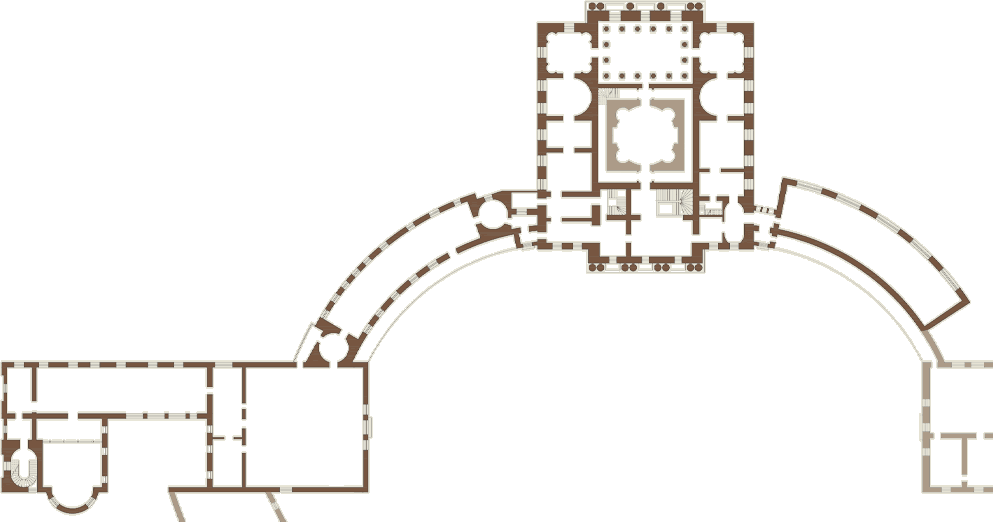The State Bedroom
Загрузка панорамы...
This is the most elegant room in the Southern Suite. It is decorated in French flair and reflects the French traditions of the royal bedrooms, which the owners of Pavlovsk encountered during their stay in France in the spring of 1782. Charles Cameron designed the original layout. The bedroom was completed in 1793–1794 per the project of Brenna, as evidenced by the design drawing stored in the Research Museum of the Saint Petersburg Academy of Arts. The final finish was largely influenced by the style of the French furniture set. The State Bedroom resembles an elegant trellis gazebo. Nature reigns here. The silk wall panels depict garlands of flowers, fruits, and agricultural tools intertwined with ribbons, among which birds, butterflies, and bees fly. The same motifs continue in the painting of the plafond and the ceiling arch, where peacocks, symbols of family happiness, sit in round lunettes. The paintings in the 18th century were executed by Johann Jakob Mettenleiter according to the sketches of the Dutch artist Willem van Leen, who worked at the French court. During their stay in Paris, the owners of Pavlovsk commissioned this carved gilded furniture set to the furniture maker Henri Jacob, who worked on it for about two years, creating a real masterpiece of furniture art. There is a master's mark on the items. The state bed is placed against the windows under a canopy. The high back is decorated with carvings depicting vases with flowers, the altar of love with cupids hovering over it, and kissing doves. There are also sphinxes, symbols of eternity, the “wakeful eye”, and hounds, symbols of loyalty. The signs of the Zodiac are depicted on the side of the back. All this symbolism is very characteristic of 18th-century art. Silk, painted with bouquets of flowers intertwined with ribbons, was used for the upholstery of furniture. It is on the pieces of furniture that the original painted silk has been preserved. It served as a model for recreating silk and painting on it for wall panels that were lost during the war. The furniture set was most likely made according to the sketches of Jean Démosthène Dugourc, one of the famous French decorators. The Russian court also commissioned him to do a silk project for a panel, which, most likely, was intended for a bedroom, but the Lyon manufactory failed to complete the order, and it was decided to replace fabric panels with painted ones. Near the bed, there are tables of French work of the 18th century; its corners are decorated with marble sculptures, A Boy with a Bird and A Girl with a Nest, acquired from the Roman sculptor Carlo Albacini during the trip.
Between the windows, on a large table, there is a vanity of 64 items made at the Sevres Royal Manufactory and presented to Maria Feodorovna by Queen Marie Antoinette of France. The dominant feature of the vanity is a large oval mirror, with a French royal mantle thrown over it, held at the top by a Russian double-headed eagle. On the sides, it is supported by elegant figures of nymphs and cupids. The vanity includes various vials, compact boxes, boxes, and caskets. They are made of deep blue porcelain called royal (bleu du roi), decorated with paintings, gilding, and applied enamels imitating precious stones. The vanity was made by the sculptor Louis Simon Boizot, as well as jewelers and enamelers Joseph Duplessis, J. Coteaux, and Le Gay. The decoration of the bedroom is complemented by other works of Sevres porcelain: two drop vases (in the corners near the windows), an aroma vase (on the console bookcase to the right of the bed), a set of three incense vases (on the fireplace).
After the fire of 1803, Voronikhin moved a white marble fireplace with inserts of colored stones (malachite, lapis lazuli, agate) from the St. Michael's Castle to the State Bedroom. Initially, Brenna designed it for Maria Feodorovna's Boudoir. Below, by the fireplace, there are two gilded bronze trivets (France, Pierre-Philippe Thomire, the 1790s) and porcelain crater vases (Saint Petersburg, the Imperial Porcelain Manufactory, the 1790s).
The chandelier is in the form of a fountain made of gilded bronze with crystal decor and ruby glass (Saint Petersburg, master Johannes Zech, 1797).
During World War II, the decoration of the Front Bedroom was almost entirely perished: the picturesque and carved decor, and the silk panels burned down, and the fireplace was significantly damaged. The interior was recreated in 1967 following the project of S. V. Popova-Gunich, the paintings on silk and plaster were executed by a group of artists following the sketches, and under the direction of A. V. Treskin; the stucco decor was created by a team of craftsmen under the direction of I. I. Kalugin, the carved decor was made by V. V. Polyakin, the marble fireplace was made by P. D. Nikanorov.
The State Bedroom on the floor plane
- The Egyptian Vestibule
- The Carpet Study
- The Second Interconnecting Study
- The Main Staircase
- The Hall of War
- The Picture Gallery
- The Upper Vestibule
- The Greek Hall
- The Third Interconnecting Study
- The Italian Hall
- The Hall of Peace
- The Throne Room
- The Valet de Chambre Room of Paul I
- The Library of Empress Maria Feodorovna
- The Pantry
- The Dressing Room of Paul I
- The Boudoir
- The Orchestral Room
- The Rossi Study
- The State Bedroom
- The Knights Room
- The Rossi Library
- The Dressing Room of Maria Feodorovna
- The Chevalier Guard Room
- The Small Study of Emperor Paul I
- The Maid of Honour's Room
- The Anteroom (Turkish Room)
- The State Library of Paul I
- The First Interconnecting Study
- The Palace Church

Back
